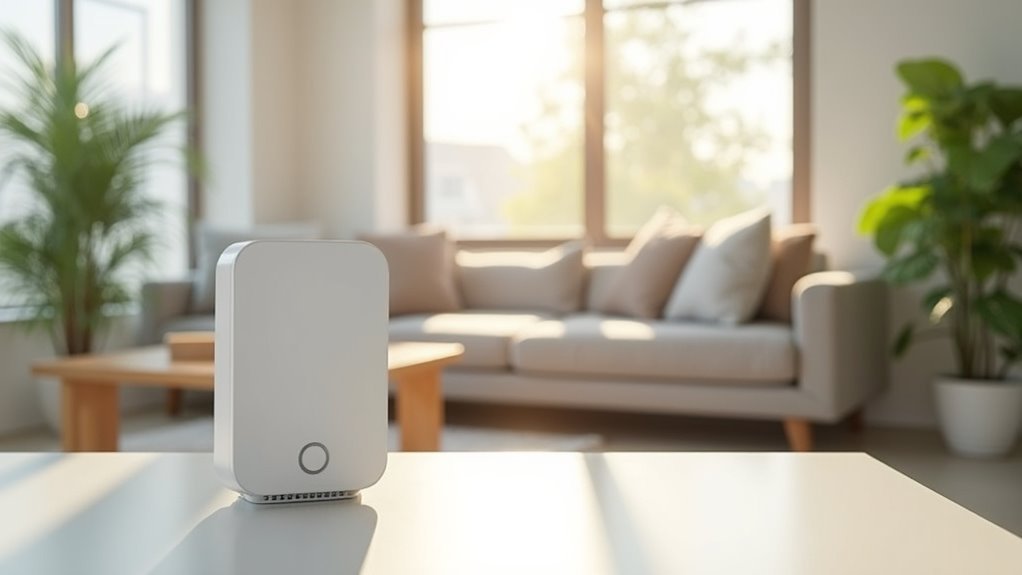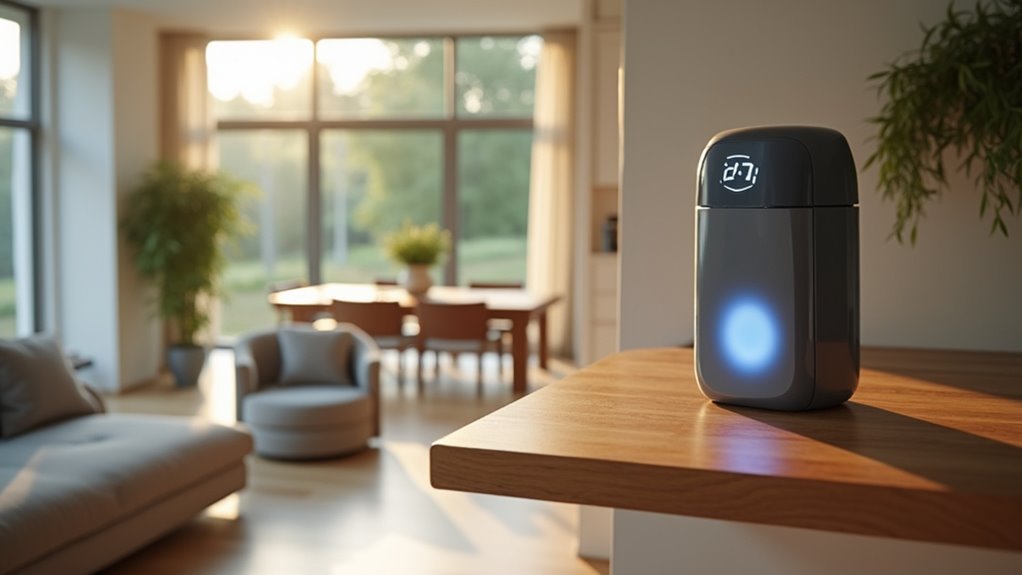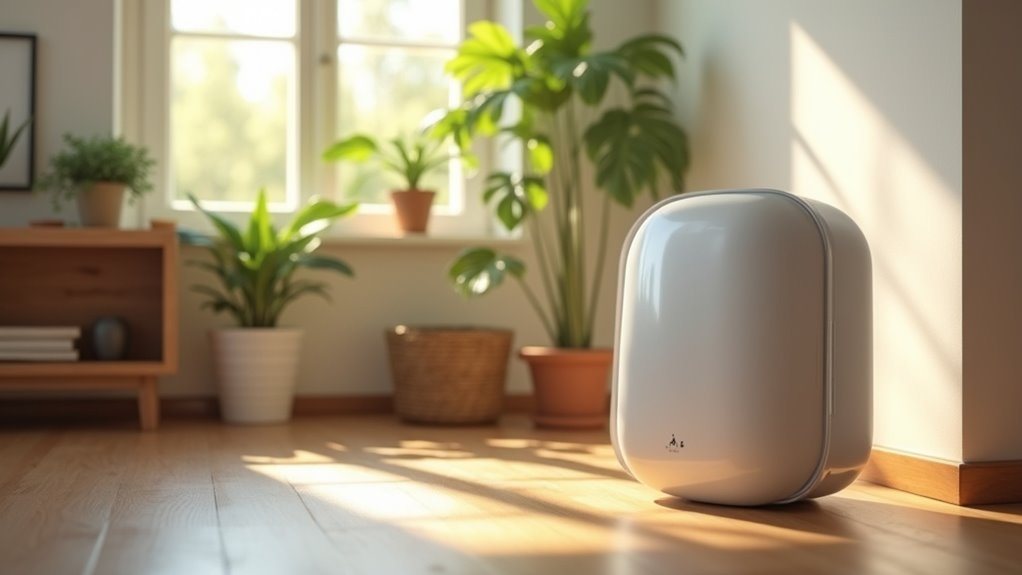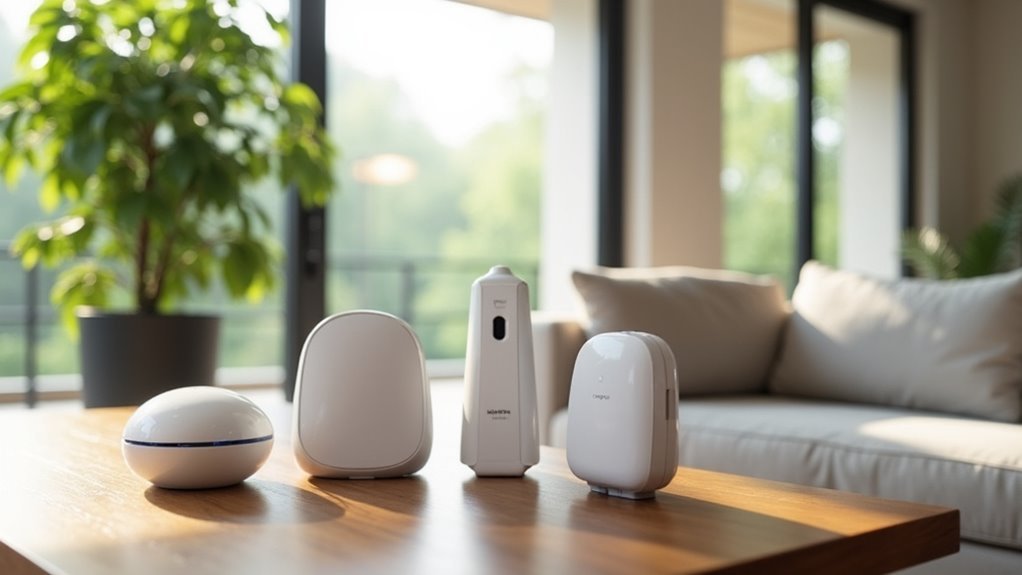You’ll find whole house ultrasonic pest repellers offer mixed results, with coverage areas reaching up to 2,000 square feet per unit. These devices emit 20-65 kHz frequencies that work best against rodents and certain insects, though they’re less effective on ants, spiders, and cockroaches. Prices range from $20-$100+ per unit, and you’ll likely need multiple devices for larger homes since ultrasonic waves can’t penetrate walls. The complete analysis below reveals which specific models deliver the most reliable performance.
How Whole House Ultrasonic Pest Systems Work

When you install a whole house ultrasonic pest system, you’re deploying technology that emits high-frequency sound waves between 20 kHz and 65 kHz to disrupt pest communication and navigation patterns.
These ultrasonic pest repellers operate beyond human hearing range while creating an uncomfortable acoustic environment for unwanted invaders.
The system works through sound wave resonance, making your home inhospitable to pests without using chemicals or traps.
You’ll get coverage area protection for spaces up to 2,000 square feet, making these pest control methods more thorough than single-device solutions.
The waves remain disruptive to pests by interfering with their natural behaviors and social communication.
You won’t see effective results immediately—most systems need several weeks to greatly impact pest habits and encourage them to relocate permanently.
Scientific Evidence Behind Ultrasonic Pest Control Technology
Understanding how ultrasonic pest systems function helps you appreciate why examining the research behind this technology matters for making informed decisions.
Scientific studies on ultrasonic pest repellents have produced mixed results, with some showing potential impact on specific pests while others find little evidence against common household invaders like cockroaches and mosquitoes.
Research on ultrasonic pest repellents shows mixed effectiveness, with limited evidence against common household pests like cockroaches and mosquitoes.
The Federal Trade Commission (FTC) has warned manufacturers about unsubstantiated claims, highlighting the lack of scientific backing for broad pest control assertions.
Research indicates that while some rodents may temporarily avoid ultrasonic frequencies, habituation often reduces long-term effectiveness.
Additionally, these devices’ limited range of 20-30 feet and obstruction by walls diminish real-world performance.
Experts recommend ultrasonic devices as part of integrated pest management rather than standalone effective solutions.
Coverage Area and Room Size Considerations

Since ultrasonic waves can’t penetrate walls or solid objects, you’ll need to carefully consider your home’s layout when determining how many devices you need and where to place them.
Most ultrasonic pest repeller units offer coverage area between 800-2,000 square feet with an effective range of 20-30 feet. However, room size and placement greatly impact performance since sound waves don’t travel through barriers.
For best results, consider these placement strategies:
- Position devices in central locations within large, open rooms
- Install separate units for each enclosed room or area
- Place repellers in basements and storage areas where pests commonly hide
- Avoid locations behind furniture or obstacles that block sound waves
- Choose advanced models offering maximum 2,000 square foot coverage for larger spaces
Proper placement guarantees your ultrasonic pest repeller system provides extensive whole-house protection.
Effectiveness Against Different Pest Types
Although ultrasonic pest repellers market themselves as universal solutions, their effectiveness varies dramatically depending on the specific pests you’re targeting.
Research from Kansas State University demonstrates this variability—their studies showed ultrasonic devices successfully reduced cricket populations but failed against cockroaches. You’ll find these devices work best against rodents and certain insects, though effectiveness often proves temporary as pests develop habituation.
Don’t expect consistent results across all pest types. Ants and spiders typically show little response to ultrasonic waves, while some customers report success with rodents and cockroaches.
The key insight here: ultrasonic devices shouldn’t be your sole pest control strategy. Instead, integrate them into a thorough approach that includes traditional methods for maximum effectiveness against your specific pest problems.
Top-Rated Whole House Ultrasonic Devices

When you’re selecting a top-rated whole house ultrasonic device, you’ll want to focus on three critical features that separate effective models from mediocre ones.
Coverage area specifications determine whether you’ll need one device or multiple units, with premium models covering up to 2,000 square feet compared to standard 800-1200 square foot ranges.
Advanced AI frequency technology and household safety features distinguish the highest-rated devices, ensuring they’re both effective against pests and safe for your family and pets.
Coverage Area Specifications
Top-rated whole house ultrasonic pest repellers deliver coverage areas that typically span 800 to 2,000 square feet, making them effective for large rooms, basements, and storage spaces.
However, you’ll need to understand their limitations to maximize performance against pests.
Most ultrasonic pest repellers have an effective range of 20-30 feet, and their ultrasonic frequencies don’t penetrate walls.
Here’s what affects your device’s coverage:
- Room layout – Walls and furniture obstruct ultrasonic waves
- Device placement – Central positioning improves overall reach
- Multiple frequencies – Advanced models enhance effectiveness
- Square footage claims – Neatmaster covers 800-1200 sq ft, premium models reach 2,000 sq ft
- Home design – Open floor plans work better than compartmentalized spaces
You’ll achieve better results by considering these coverage area specifications when selecting your ultrasonic pest repeller.
AI Frequency Technology
Since modern AI-powered ultrasonic pest repellers can dynamically adjust their frequencies between 8 kHz and 65 kHz, they’re able to target a broader spectrum of pests more effectively than fixed-frequency models.
These advanced devices use patented sound wave resonance technology that’s been recognized by U.S. utility patents for its innovation.
You’ll find dual-mode functionality particularly useful – Red Mode delivers powerful high-frequency sound for larger pests in unoccupied spaces, while Blue Mode provides quieter operation for occupied areas, specifically targeting smaller pests like mosquitoes and cockroaches.
The AI technology continuously adapts frequency patterns to prevent pests from becoming accustomed to specific sound wavelengths. This intelligent frequency modulation makes these ultrasonic devices considerably more effective than traditional static-frequency repellers at maintaining long-term pest control.
Safety for Households
Because household safety remains a top priority for families considering pest control solutions, ultrasonic pest repellers offer a compelling chemical-free alternative that protects both humans and most pets.
These devices utilize non-toxic technology that eliminates exposure to harmful chemicals commonly found in traditional pest control methods.
The high-frequency sound waves these ultrasonic pest devices emit provide several safety advantages for households with children:
- Silent operation for humans while targeting pest communication systems
- No poisonous baits or traps that curious children might accidentally touch
- Continuous protection without requiring hazardous spray applications
- Easy plug-in setup that eliminates handling of toxic substances
- Chemical-free environment promoting healthier indoor air quality
However, pet owners should monitor small animals like guinea pigs and hamsters, as they may exhibit sensitivity to ultrasonic frequencies.
Safety Considerations for Families and Pets
While ultrasonic pest repellers promise a chemical-free solution to household infestations, you’ll need to carefully evaluate their safety impact on your family and pets before installation.
These safety considerations become critical when you own small animals like guinea pigs, hamsters, or rabbits. Since ultrasonic pest repellers operate above 20 kHz, they can cause significant discomfort to these sensitive pets, potentially triggering anxiety and unwanted behavioral changes.
The Federal Trade Commission (FTC) has issued warnings about unsupported manufacturer claims regarding these devices’ safety and effectiveness against household pests.
If you have family members using hearing aids or pacemakers, exercise extra caution, as ultrasonic frequencies may interfere with medical device functionality. Always weigh these potential risks against the promised benefits.
Installation and Placement Guidelines
Proper placement determines whether your ultrasonic pest repellers will effectively target household infestations or simply waste electricity. Strategic installation maximizes your devices’ effective range of 20-30 feet while avoiding common mistakes that reduce performance.
Strategic placement is the difference between effective pest control and wasted energy with ultrasonic repellers.
Follow these essential placement guidelines:
- Position devices in open areas away from walls, furniture, and obstacles.
- Install one unit per room where pest activity occurs, since ultrasonic waves don’t penetrate walls.
- Mount devices 3-5 feet above ground level for ideal wave dispersion.
- Use multiple devices in homes exceeding 2,000 square feet or complex layouts.
- Regularly adjust placement if pest activity persists despite initial installation.
Environmental factors and background noise can interfere with effectiveness, so you’ll need to monitor performance and relocate units when necessary for maximum pest control results.
Cost Analysis and Value Comparison
Budget considerations play an essential role when evaluating ultrasonic pest repellers against traditional control methods. Your cost analysis should include initial device prices ranging from $20 to over $100, plus potential fluctuations based on effectiveness claims.
While professional pest control services cost $100-$300 per treatment, ultrasonic pest repellers offer lower upfront costs but may require multiple units for larger homes, increasing your overall expenditure.
You’ll find coverage areas typically span 800-2,000 square feet, meaning whole-house protection often demands several devices. Customer reviews averaging 3.7-4.9 stars reveal mixed satisfaction levels, emphasizing the importance of researching specific models.
Though these devices present an affordable alternative to chemical methods, you might need supplementary pest management strategies, potentially offsetting initial savings.
Limitations and Performance Factors
You’ll face significant range limitations when using ultrasonic pest repellers, as most devices only cover 20-30 feet effectively, requiring multiple units for whole-house protection.
Physical barriers like walls and furniture can block ultrasonic waves, creating dead zones where pests remain unaffected.
Over time, you’ll likely notice diminishing results as rodents and other pests adapt to the constant ultrasonic frequencies, forcing you to contemplate supplemental pest control methods.
Range and Coverage Issues
While ultrasonic pest repellers promise whole-house protection, their actual coverage falls considerably short of most homeowners’ expectations.
These devices typically offer an effective range of just 20-30 feet, creating significant range and coverage issues for larger homes.
Several factors limit ultrasonic pest repellers’ effectiveness:
- Sound waves can’t penetrate walls, furniture, or solid objects
- Multiple units are necessary for multi-room coverage
- Environmental factors like background noise interfere with signals
- Individual circumstances of your home layout affect performance
- Pest infestations vary in severity and location
You’ll likely need several units strategically placed throughout your home to achieve meaningful coverage.
Even then, furniture placement and room configuration can create dead zones where pests remain unaffected by the ultrasonic frequencies.
Pest Adaptation Problems
Even if you overcome the coverage limitations, ultrasonic pest repellers face a more fundamental challenge: pests adapt to the constant sound waves over time.
These pest adaptation problems greatly reduce long-term effectiveness as rodents and other creatures habituate to the repetitive frequencies. You’ll find that what initially drives pests away becomes background noise they simply ignore after weeks or months of exposure.
Different species respond variably to ultrasonic waves, creating inconsistent results throughout your home.
While cockroaches might show temporary sensitivity, ants and spiders often remain completely unaffected.
Background noise from appliances, HVAC systems, and daily activities can interfere with ultrasonic frequencies, further compromising performance.
This adaptation issue makes ultrasonic pest repellers unreliable for sustained pest control.
Alternative Pest Control Methods to Consider
Before investing in ultrasonic pest control devices, consider several proven alternatives that might better suit your specific situation. Many homeowners find these methods more reliable than ultrasonic devices for addressing pest problems.
Most homeowners discover that traditional pest control methods deliver more consistent results than ultrasonic devices for eliminating unwanted pests.
- DIY pest control using homemade traps and natural repellents effectively targets specific pests without harsh chemicals.
- Sealing entry points like cracks in walls, doors, and windows considerably reduces infestation likelihood by blocking pest access.
- Traditional traps for rodents and insects provide immediate results when strategically placed, outperforming ultrasonic alternatives.
- Chemical pesticides eliminate infestations quickly in targeted areas when you follow manufacturer’s instructions properly.
- Professional pest control services offer thorough inspections, customized treatment plans, and expert long-term management strategies for severe infestations.
Frequently Asked Questions
Do Ultrasonic Pest Repellers Really Work?
You’ll find ultrasonic pest repellers show mixed results. They’re somewhat effective against cockroaches but only temporarily deter rodents. Most scientific studies don’t support manufacturer claims, so you shouldn’t rely on them alone.
What Are the Disadvantages of Ultrasonic Pest Repellers?
You’ll face limited effectiveness against many pests, restricted range coverage, pest habituation over time, interference from household noise, and potential harm to small pets like hamsters and guinea pigs.
What Is the Ultrasonic Pest Repeller Lawsuit?
You’re dealing with FTC lawsuits against ultrasonic pest repeller manufacturers who made false effectiveness claims. Companies faced legal action for misleading advertising, resulting in settlements requiring refunds and stopping unsubstantiated marketing promises.
Do Ultrasonic Pest Repellers Work Consumer Reports?
Consumer Reports finds ultrasonic pest repellers largely ineffective against common household pests like cockroaches and ants. You’ll see mixed results at best, with limited scientific evidence supporting manufacturers’ claims about their effectiveness.
In Summary
You’ll find that whole house ultrasonic pest systems offer a chemical-free approach to pest management, though their effectiveness varies greatly depending on your home’s layout and pest types. While they’re easy to install and maintain, you shouldn’t rely on them as your sole pest control method. Consider combining ultrasonic devices with traditional approaches for better results. Research coverage areas carefully and choose devices that match your specific needs and budget constraints.





Leave a Reply